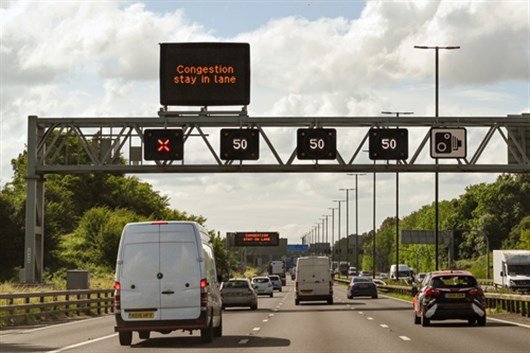Clampdown on motorists ignoring red X lane closures on smart motorways

- National Highways is installing new 95 safety cameras to enable automatic detection of vehicles that ignore red X lane closure signals.
- Drivers who ignore a a red X sign face a £100 fine and three penalty points.
- Other safety technology is being fitted to existing smart motorways.
Motorists who ignore red X lane closures on smart motorways and put lives at risk face a clampdown.
National Highways, which manages the network, is installing 95 new safety cameras to enable automatic detection of vehicles that ignore red X lane closure signals. The cameras will be live by the end of September.
It is illegal to ignore a lane closure on the motorway and drivers who do so will face a £100 fine and three penalty points on their licence.
National Highways said the cameras will increase compliance with the red X, helping to ensure the safety of drivers and their passengers in difficulty, or road workers and emergency services who need a safe space to work.

The main concern motorists have about smart motorways, according to National Highways, is breaking down in a live lane, although only ‘a very small proportion of total journeys on any road result in a live lane breakdown’.
National Highways also expects to complete the roll-out of radar-based technology that can spot a stopped or broken-down vehicle on more than 200 miles of all-lane running motorway by the end of September.
More signs informing drivers of the distance to the next place to stop in the event of a mechanical problem or emergency are also being installed.
The commitments have been made in the Smart Motorway Stocktake – Second Year Progress Report published by National Highways.

The report follows the action plan first published by transport secretary Grant Shapps (pictured) in 2020 and an 'accelerated timetable' published last year.
Nick Harris, chief executive of National Highways, said: “Our network is relied upon by an ever-increasing number of people to work, visit family and friends, do business and much more. It is only right that these drivers and their passengers are safe and, crucially, feel safe on our roads, including smart motorways.
“It is now two years since the transport secretary first published the smart motorway stocktake and today’s report shows that we are making good progress delivering on these ambitious recommendations. But we are not complacent.
"The latest data shows that, overall, in terms of serious or fatal casualties, smart motorways are our safest roads. We are continuing our work to make them our safest roads in every way. We will continue to build on the work already undertaken and continue to put safety first to help ensure drivers have confidence in the motorway network.”
"The key question is whether these changes are enough to reassure drivers." RAC head of roads policy Nicholas Lyes
Reacting to the publication of the second year progress report, RAC head of roads policy Nicholas Lyes said: “While good progress is being made in upgrading existing smart motorways by installing stopped vehicle detection technology and more refuge area signage, the key question is whether these changes are enough to reassure drivers, many of whom firmly believe that removing the hard shoulder compromises safety.
"While the Government is keen to point out that all-lane-running smart motorways tend to have a better overall safety record than conventional motorways, the safety comparisons with other types of smart motorways are less impressive.”
Smart motorways have been heavily criticised by safety campaigners and in January the Government decided to pause their construction until five years' worth of data has been collected.
What is a smart motorway?
There are three types of smart motorway:
- All-lane running: the hard shoulder is permanently converted into a live lane and there are emergency refuge areas at regular intervals.
- Dynamic hard shoulder: the hard shoulder is converted to a live lane at peak times of congestion.
- Controlled: a motorway with three or more lanes, a hard shoulder and variable speed limits
Why were smart motorways introduced?
Smart motorways were introduced as a way of managing traffic and easing congestion, without having to widen roads.
Where are smart motorways located?
There are around 375 miles of smart motorways on sections of the M1, M3, M4, M5, M6, M20, M23, M25, M27, the M40/M42 interchange, M56 and M62.
Here is a map of the UK's smart motorway network, which is managed by National Highways (formerly Highways England).
Is a red cross over a smart motorway lane advisory or mandatory?

What should we do if we break down in the live lane of a Smart motorway?


